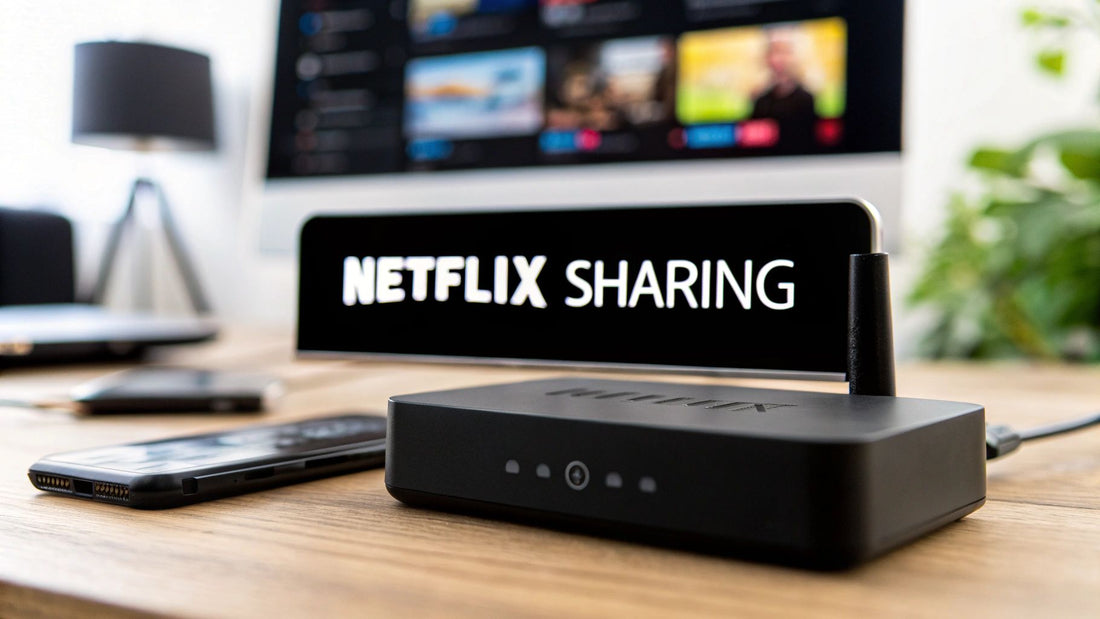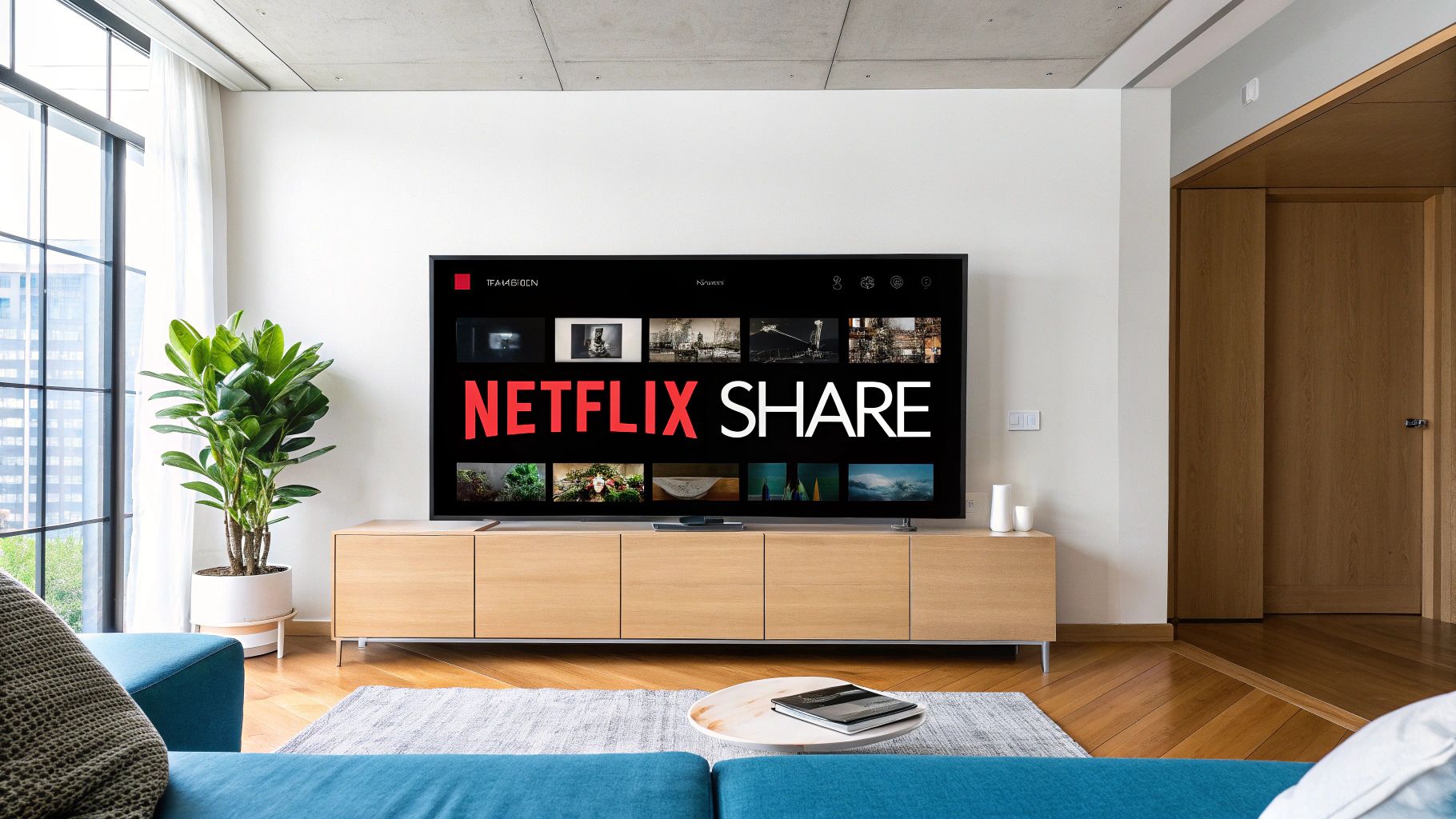
Can Netflix Be Shared? Explore Policies & Tips
Share
The Evolution of Netflix's Sharing Landscape

Remember sharing your Netflix password? It used to be common practice. The streaming giant even seemed to encourage it. But those days are over. This section explores Netflix's shift from relaxed sharing to its current restrictions.
From Open Sharing to Household Focus
Netflix's early growth strategy partially relied on widespread account sharing. This boosted brand visibility and introduced the platform to new viewers. However, as the streaming market became more competitive, Netflix recognized the potential revenue loss from unrestricted sharing. This realization led to a policy change. The company now emphasizes the "household," aiming to keep sharing within those limits.
Sharing within a family living together is still fine. Extending access to friends or family living elsewhere is now against the rules. This new approach led to updates in Netflix's terms of service and new technical measures to stop unauthorized sharing. The change mirrors industry trends toward tighter account access and maximizing revenue. You might be interested in: Our blog's sitemap for more related content.
Defining a Netflix Household
Netflix's "household" definition is key to understanding its sharing policy. It's not just about family; it's about a primary location. This location is typically identified by things like IP addresses and device usage. The platform looks for regular viewing from devices at the primary location to confirm they belong to the same household.
Netflix also monitors for unusual activity, like simultaneous streaming from geographically distant locations. This can trigger alerts and verification requests. Despite these changes, Netflix's subscriber base continued to grow. In the first quarter of 2024, Netflix gained 9.33 million subscribers globally, partly due to their efforts to limit password sharing. By the end of Q4 2024, they had over 300 million paid subscribers worldwide. You can find more detailed statistics here: Netflix Statistics. These stricter policies highlight Netflix's focus on increasing revenue while maintaining a broad subscriber base. This shift reflects a challenge facing streaming services: balancing growth and profitability in a competitive market.
How Netflix Catches Unauthorized Sharing

This section explains how Netflix identifies unauthorized account sharing. The company uses a combination of methods to monitor and control who's accessing an account and when. Understanding these methods can help you stay within Netflix's guidelines.
IP Address Monitoring
Netflix keeps track of the IP addresses used to access an account. Your IP address acts like a digital identifier for your internet connection. Consistent access from a single IP address generally indicates normal household use.
However, frequent access from multiple, geographically distant IP addresses can trigger alerts. For example, if your account is consistently used in London and suddenly shows activity from Sydney every day, Netflix may suspect unauthorized sharing.
Device Fingerprinting
Device fingerprinting is another tool Netflix uses. This technique identifies individual devices accessing an account by their unique software and hardware characteristics, creating a digital "fingerprint" for each one.
While multiple devices within a single household are expected, an excessive number of different device fingerprints linked to one account can raise suspicion. If, for instance, a dozen different devices across the country log into your account in a short period, Netflix will likely take notice.
Viewing Pattern Analysis
Netflix also analyzes viewing patterns. This involves tracking what's being watched, when, and on which devices. Unusual shifts in viewing habits can indicate potential sharing violations.
Imagine a profile that typically streams children's cartoons suddenly switching to horror movies from a different location. This type of activity might suggest unauthorized access.
To better understand these detection methods, let's look at the following table. It summarizes how Netflix identifies potential account sharing and the possible impact on users.
Netflix's Account Sharing Detection Methods
| Detection Method | How It Works | Potential User Impact |
|---|---|---|
| IP Address Monitoring | Tracks the IP addresses used to access an account. Frequent access from diverse locations raises red flags. | Account suspension, verification requests, limited access |
| Device Fingerprinting | Identifies devices based on unique hardware/software configurations. Too many different devices on one account triggers scrutiny. | Account suspension, verification requests, limited access |
| Viewing Pattern Analysis | Analyzes what is watched, when, and on which devices. Unusual changes in viewing habits may indicate unauthorized access. | Account suspension, verification requests, limited access |
As this table shows, Netflix employs several techniques to detect unauthorized sharing, all of which can lead to consequences for users.
Verification Challenges and User Experiences
When Netflix detects suspicious activity, it may issue a verification request. This usually involves sending a code to the account holder's email or phone number to confirm the user is authorized.
Some users report receiving warnings about exceeding device limits or unusual viewing activity before a verification challenge is issued. These experiences highlight the consequences of unauthorized Netflix sharing. Being aware of how Netflix monitors account access can help you avoid interruptions to your streaming.
Sharing Possibilities Across Netflix Subscription Tiers

Not all Netflix subscriptions are created equal when it comes to sharing. This section breaks down the sharing features and limitations of each tier. We'll explore the key difference between user profiles and simultaneous streams, and how these factors impact various household setups. Understanding these nuances is key to getting the most value from your Netflix subscription. So, can you share your Netflix account? Yes, but there are rules.
Understanding User Profiles and Simultaneous Streams
Many subscribers confuse user profiles with simultaneous streams. A user profile allows for personalization. Each profile tracks viewing history, preferences, and makes tailored recommendations. Think of profiles as separate accounts within your main subscription. This lets family members curate their own personalized Netflix space.
Simultaneous streams, on the other hand, determine how many devices can actively watch Netflix at the same time, regardless of the profile being used. Two people could watch different content on two TVs under one profile, or each could use their own profile. The limiting factor is the number of simultaneous streams allowed by your chosen subscription tier.
Netflix Subscription Tier Breakdown
The number of profiles and simultaneous streams you get depends on your Netflix subscription tier. This has a direct impact on sharing within your household. Let's examine each tier in detail:
-
Basic: The Basic plan permits only one simultaneous stream and one user profile. This tier is ideal for individual users.
-
Standard: The Standard plan offers two simultaneous streams and up to five user profiles. This tier is a good fit for couples or small families.
-
Premium: The Premium plan provides four simultaneous streams and up to five user profiles. This is the best choice for larger households or those with multiple viewers.
To help visualize the differences, let's take a look at a comparison table:
To help you compare the different Netflix plans, we've created a table summarizing the key features of each tier:
Netflix Subscription Tiers Comparison: A comprehensive comparison of Netflix's subscription plans and their sharing capabilities.
| Subscription Tier | Price (USD, Example) | Simultaneous Streams | User Profiles Allowed | Video Quality | Best For |
|---|---|---|---|---|---|
| Basic | $9.99 | 1 | 1 | SD | Individuals |
| Standard | $15.49 | 2 | 5 | HD | Couples, Small Families |
| Premium | $19.99 | 4 | 5 | UHD/4K | Large Families, Frequent Viewers |
As this table clearly illustrates, each tier caters to different needs and viewing habits. Choosing the right tier depends on how many people will use the account and how they prefer to watch.
Premium Plan Advantages for Sharing
The Premium plan offers significant advantages for households with multiple viewers looking to share their Netflix account legitimately. With four simultaneous streams, family members can enjoy different shows concurrently without interruption. The Premium tier also boasts the highest video quality, including Ultra HD and 4K, delivering a superior viewing experience, particularly on larger screens. While sharing detection applies to all tiers, the impact may be less pronounced on the Premium plan due to its generous allowance of simultaneous streams.
Choosing the correct Netflix tier is crucial for an enjoyable, interruption-free streaming experience. Consider how many people will be using the account and their viewing habits. The next section will explore the "Extra Member" feature, which provides an official way to extend sharing beyond your immediate household.
The Extra Member Option: Official Sharing Beyond Home

Netflix's "Extra Member" feature marks a significant shift in the company's stance on account sharing. Instead of discouraging the practice, Netflix has found a way to monetize it. This section explores this official sharing option, examining its availability, cost, requirements, and overall value.
Regional Availability and Pricing
The Extra Member feature is not universally available. Netflix has opted for a staggered rollout, with pricing variations depending on the region. This allows the company to gauge market response and adjust the feature accordingly. Consequently, users need to verify its availability in their specific location.
The cost of an Extra Member is typically less than a full separate subscription, but it does increase the overall cost of your current plan. For example, an Extra Member fee of $5 per month added to a $15 Standard plan brings the total monthly expense to $20. You might be interested in learning more about shared accounts: Learn more about shared accounts in our article.
Eligibility and Account Management
Certain eligibility criteria apply to adding Extra Members. The primary account holder must be subscribed to either a Standard or Premium plan. The Basic plan does not support this feature.
Managing Extra Members is handled through your Netflix account settings. Adding or removing members is straightforward. Importantly, each Extra Member receives their own login credentials and profile, separate from the main account profiles. This allows for a personalized viewing experience.
Is It Cost-Effective?
The cost-effectiveness of adding an Extra Member hinges on individual circumstances. If you already have a Standard or Premium plan and wish to share with someone outside your household, it might be more economical than a second subscription.
However, if you intend to share with multiple people outside your home, separate subscriptions or alternative services with more flexible sharing options might be a better fit. Services like AccountShare offer a potential solution. Netflix boasts impressive global reach. As of 2025, the Europe, Middle East, and Africa (EMEA) region had over 101 million subscribers, slightly surpassing the approximately 90 million subscribers in the U.S. and Canada. Interestingly, North America generated higher revenue per user, averaging around $17 in Q3 2024. Learn more: Netflix User Statistics. This regional disparity highlights how localized content influences subscriber acquisition and retention worldwide.
User Experiences and Content Access
The experience for Extra Members differs slightly from that of primary account holders. Access is restricted to the primary account holder's region. This means that during travel, an Extra Member's content options will mirror those of the primary account's home region.
While Extra Members enjoy individual profiles and personalized recommendations, the recommendation algorithm may still be influenced by the primary account's viewing history. Some users have reported this affecting the suggestions they receive.
The Legal Reality of Netflix Password Sharing
Is sharing your Netflix password illegal? This section clarifies the legal ramifications of account sharing. We'll explore the difference between violating terms of service and breaking the law, examining Netflix's user agreement and how it has evolved. We’ll also consider Netflix's global enforcement practices and any potential future legislation that could impact your sharing habits.
Terms of Service vs. The Law
Violating Netflix's terms of service isn't the same as breaking the law. A terms of service agreement is a contract between you and Netflix. Breaking this contract could lead to account suspension or termination, but it's rarely a criminal offense. Think of it like breaking a gym membership agreement—you might incur penalties, but you won't face legal prosecution.
Actual illegality involves violating copyright law, a much more serious matter. While Netflix's terms of service restrict sharing outside your household, sharing itself doesn't typically infringe on copyright. However, widespread, commercialized password sharing could potentially cross that line.
Netflix's Evolving User Agreement
Netflix's user agreement explicitly addresses password sharing. Over time, it has become stricter, reflecting the company's shift from encouraging to restricting the practice. The agreement clearly states that accounts are for use within a single household. Sharing with friends across the country, for example, now explicitly violates these terms. You can find more information here: AccountShare's collection of resources.
Netflix's Enforcement Practices
Netflix's enforcement of its sharing policy varies globally. While the terms of service apply everywhere, the rigor of enforcement differs based on factors like regional subscriber growth and market conditions. In some regions, Netflix actively detects and addresses unauthorized sharing, implementing stricter measures like verification requests and account restrictions. In other areas, enforcement may be less stringent. This nuanced approach reflects a strategy tailored to each market’s specific dynamics.
Emerging Legislation and Future Impacts
As streaming grows in popularity, laws regarding digital service sharing are evolving. Some countries are exploring legislation that could clarify the legality of password sharing, potentially introducing penalties for widespread unauthorized access. Staying informed about these legal developments is crucial for avoiding unintended consequences.
Understanding Your Legal Position and Practical Risks
While the legality of password sharing remains a developing area, understanding your position is essential. By staying informed about Netflix's terms of service and any relevant legislation in your area, you can better assess the practical risks involved. This proactive approach helps you make informed decisions about your Netflix account and avoid potential problems. Awareness of potential changes in laws and enforcement strategies will allow you to navigate the future of Netflix sharing with confidence.
Beyond Sharing: Smart Alternatives To Consider
With stricter rules around sharing accounts, you might be wondering about your options for accessing the content you enjoy. This section provides a practical guide for navigating the streaming world in the wake of the sharing crackdown. We'll explore the cost, content, and user experience of different platforms with more flexible sharing policies. We'll also look at strategic approaches to managing subscriptions, such as rotating services monthly, which can often be more cost-effective than a premium shared account.
Exploring Alternative Streaming Platforms
While Netflix remains a major player, other streaming platforms offer comparable libraries and features. Some even maintain more relaxed approaches to account sharing. Exploring these alternatives can open up valuable opportunities to access diverse content without running afoul of new sharing restrictions.
-
Amazon Prime Video: Often bundled with an Amazon Prime membership, this service boasts a large selection of movies and TV shows, including original content. Prime Video also allows users to download content for offline viewing, a convenient feature for those on the go.
-
Hulu: Known for its current-season TV shows, Hulu offers a substantial library of movies and original programming as well. Hulu + Live TV provides access to live television channels, bringing another dimension to the platform.
-
Disney+: Home to Disney classics, Marvel, Star Wars, and National Geographic content, Disney+ is a popular choice for families. The platform supports multiple user profiles and simultaneous streams.
-
HBO Max: Offering a curated selection of movies and TV shows, including critically acclaimed HBO series, HBO Max is frequently praised for its high-quality original content.
The Economics of Family Plans
Many streaming services offer family plans, which can be a good fit for larger households. These plans typically allow multiple simultaneous streams and individual profiles. However, whether or not a family plan makes financial sense depends on your viewing habits and the number of users.
| Streaming Service | Family Plan Price (USD, Example) | Simultaneous Streams |
|---|---|---|
| Amazon Prime Video (Included with Prime) | $14.99/month or $139/year | 3 |
| Hulu (No Ads + Live TV) | $82.99/month | Unlimited in-home + 3 mobile |
| Disney+ (Duo Premium) | $19.99/month | 4 |
| HBO Max (With Ads) | $9.99/month (limited to 2 concurrent streams) | 2 concurrent, unlimited registered devices |
Comparing the costs of individual versus family plans, relative to your actual viewing needs, will reveal the most economical choice. Consider how often multiple household members will be streaming at the same time.
Strategic Streaming Management: Rotation and Tracking
Rotating streaming services can be an effective cost-saving measure. Subscribing to different platforms on a monthly basis allows access to a broader range of content at a potentially lower overall cost than maintaining several concurrent subscriptions.
Using content tracking systems and subscription management tools can simplify this process. These tools help you keep tabs on what’s available on each platform and when your subscriptions are due for renewal, making it easier to strategically plan your viewing schedule.
Real User Strategies for Maximizing Value
Resourceful viewers have developed clever strategies for managing their streaming consumption within the boundaries of sharing rules. Some organize watch parties, rotating hosting responsibilities and subscriptions among friends. Others carefully track new releases on various platforms to strategically time their subscriptions. Still others rely on subscription management apps to avoid overlapping subscriptions and prevent unwanted renewals. By employing these techniques, viewers can enjoy the content they want without breaking the bank or platform policies.
If you want a more efficient method for managing and accessing premium subscriptions, check out AccountShare. This platform provides a secure and streamlined way to share accounts and lower costs through group purchases. Discover how AccountShare can enhance your digital experience and maximize your subscription value.
